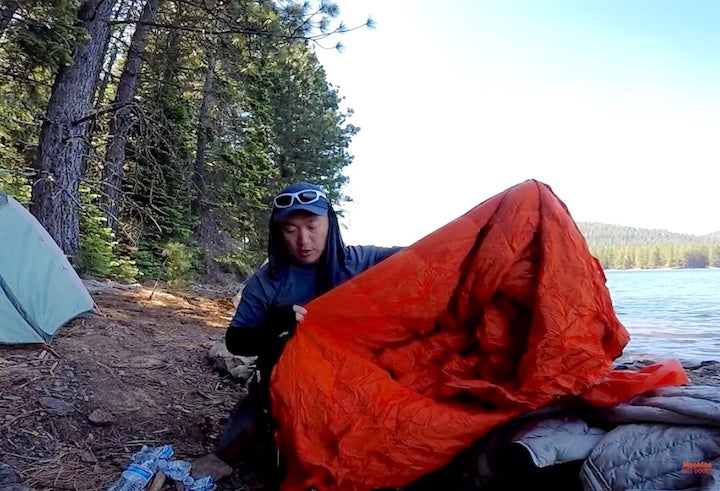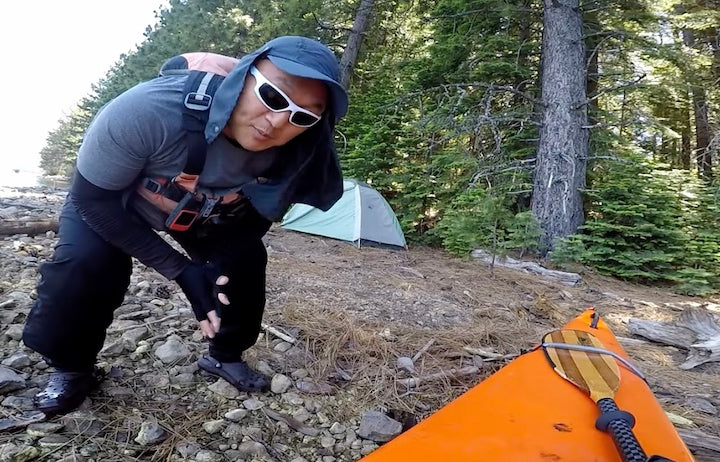Gear List for Kayak Camping
5-minute read + 11-minute video
Ever wonder what to bring along for a kayak fishing and camping trip? Bending Branches Regional Ambassador Moo Lee shares his gear list with us from a recent trip of his.

There are a couple of different types of kayak camping options: camping at designated campsites and dispersed camping.
Designated campsites may have a firepit and and grate, and sometimes a designated toilet. Some of them will offer potable water. Most likely you’ll still need to pack out all your trash.
Dispersed camping means making camp where there are no designated sites, like along a lakeshore or the ocean shoreline. Dispersed camping means there will be nothing there—no firepit, no water, no toilet. Just a place to pull up your kayak and set up your tent.
(NOTE: Dispersed camping isn’t OK just anywhere—be sure you check on your route before you head out.)
In the video below, Moo Lee shares his dispersed camping kit when he goes for an overnight kayak fishing trip. His tips here don’t include his fishing gear, so this video also applies to anyone looking for general kayak camping gear tips. And most of these apply to designated or dispersed camping
Watch below:
Moo says, “Since we’re kayak packing and not backpacking we have a little bit more space to carry our stuff.” There’s also less concern about weight since the only time you’ll carry your gear is from your kayak to your vehicle or the shore.
Because of the shape of your kayak, you’ll want to pack your gear into many smaller bags rather than a couple of large ones. This is so you can stuff them into the long, narrow compartments at the bow and stern.
Anything you don’t want wet (like your sleeping bag and extra clothes) should be packed inside waterproof dry bags. Even though a kayak’s compartments are fairly watertight, water will still make its way inside.
Camp Kitchen and Food
Inside Moo’s camp kitchen dry bag is a small bear canister with dry food, spices, toothpaste, and anything else that has an odor that would attract critters. Bears aren’t the only animals that would find your food tempting—raccoons, squirrels and chipmunks are often more of an issue.
He also includes his utensils and bowl or plate in this dry bag. And finally his cooking system. Moo likes the Firemaple Polaris. The pot, stove, fuel canister and stand can be combined into one system that stows easily. Any compact system works well though.

Moo and his tripmate also brought fresh veggies for their evening meal. Since they were going to eat them right away they could be stored in a plastic grocery bag right in the kayak compartment. They planned to eat the fish they caught so they could cut down on what food they brought along.
For drinking water and dishwashing, they decided to bring water with them since they had room. But a good water filter is really all you need when you’re kayak camping, as you’ll be surrounded by water.
Tent and Sleep System
Moo and his buddy both brought a one-person tent with a fly/vestibule. It’s a good idea to separate the tent itself from the stake/pole bag so the tent can go inside a waterproof dry bag in the kayak.
An inflatable sleeping pad packs down nice and small. If the nights are cold where you’ll be camping consider investing in a pad that has a decent R-factor for insulation. He uses a battery-powered pump to inflate it that also doubles as a lantern.
Moo’s zipperless sleeping bag is from Sierra Designs with the very handy feature of a slipcase that attaches it to his sleeping pad. This prevents his bag from sliding off the pad every time he turns over at night. Somebody was thinking!
He also packs along a light down blanket from Get Out Gear. He can use this for extra warmth around camp if needed. It also gives him another option for sleeping if his bag is too warm for the nighttime temperature.

Personal Gear and Ditty Bag
Other personal gear items Moo likes to include on his kayak camping trips are a mosquito candle and a lightweight portable camp chair.
Don’t forget a change of dry clothes packed in a waterproof dry bag. Moo even packs his extra clothes in a compression sack inside the dry bag for extra protection. He also brings a fishing jacket for colder temps or rain and a packable down jacket for some more insulation.
When preparing for dispersed camping, it's essential to include wag bags in your gear. These are designed for the disposal of solid human waste. In many wilderness places, especially next to lakes and rivers, digging a foxhole doesn’t cut it. Rather, regulations ask you to pack out everything, even poo (and feminine products).
A wag bag is made for this. Inside there’s a solidifying powder that chemically alters the consistency and odor. It’s contained in a ziplocked bag you pack out with you and can just toss in the trash once you’re back.
Other items to pack in your ditty bag are a comprehensive First Aid kit, ointments, a battery pack and extra batteries for anything you have along. If you’ll be out of cell range and plan to be gone for a few days, consider renting or buying a handheld VHF radio for emergencies.

So there you have a great starting point for gearing up for your own kayak camping adventures. If you plan to fish you’ll need to be sure to save room for tackle and other fishing gear.
Happy camping!
Do you have paddle questions our friendly Customer Service Team can help you with today? Contact them: 715-755-3405 • bbinfo@bendingbranches.com
More for you...










